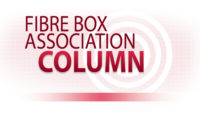FBA Column
Boxes Are the Backbone of E-Commerce




For over a century corrugated packaging has carried products around the world, delivering everything from machine parts to computers and food from point of origin to point of use. Throughout its history, the corrugated industry has continually improved its products to accommodate evolving user requirements and “rules of the road.”
Corrugated’s adaptability is more crucial than ever with the growth of e-commerce. Before online shopping, corrugated boxes were used primarily to deliver cases of products to manufacturers or stores, serving a purely utilitarian purpose. Brand promotion was typically reserved for primary packages such as folding cartons, which were packed inside the corrugated boxes, and then removed and placed on retail shelves.
E-commerce turns that dynamic on its head. Recent reports indicate exponential growth in online shopping; a new market study by eMarketer estimates global e-commerce rising 20.7% in 2019 to $3.535 trillion. Amazon Prime Day in July 2019 was the largest shopping event in Amazon history with more than 175 million items ordered. Two days of Prime Day sales surpassed the previous Black Friday and Cyber Monday sales combined. It all adds up to radical changes in supply chains and packaging paradigms.
Products ordered online are shipped directly to consumers — often in single units. They still require shipping containers that can withstand the rigors of transport to protect them from damage in transit. But now those same shipping boxes can also serve as mobile billboards to promote a brand.
Today, roughly 10% of total U.S. boxes are used for e-commerce, but total box production has remained stable; e-commerce has absorbed some of the packaging that previously was supplied to commercial users. U.S. corrugated industry shipments peaked in 1999 at 405 billion SF produced at 1,463 box plants. Productivity gains have enabled 393 billion SF to be produced by 1,146 box plants today.
New printing technologies are enabling box manufacturers to print sharp, colorful graphics even on the inside box surfaces. The added impact can be dramatic — helping to create “unboxing” experiences worthy of social media shares to further extend a brand’s message in new ways that resonate with today’s consumers. Digital printing also enables greater use of customized packaging for regional, seasonal and specially segmented marketing campaigns all delivered direct to the targeted consumer.
Consumers also care about packaging’s environmental impact, rising with public scrutiny and discussion about plastics in the ocean. They want minimized packaging. Corrugated boxes can be right-sized for any product and serve double duty as shipping and merchandising container, giving brands an opportunity to align their packaging with consumer values. Consumers feel good about corrugated boxes because more than 96% of them are recycled, and the average box includes 50% recycled content. Most boxes are imprinted with the Corrugated Recycles symbol, reminding consumers to do their part.
Boxes are an ordinary part of everyday life, more visible than ever due to growth in e-commerce. Yet they provide extraordinary value by sustainably delivering the products consumers want in pristine condition. Thrilling unboxing experiences benefit not only the happy customers, but the brands that supply their favorite things.
Looking for a reprint of this article?
From high-res PDFs to custom plaques, order your copy today!








